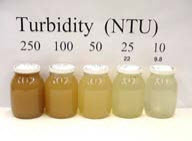Difference between revisions of "Turbidity"
Cellsworth (Talk | contribs) |
Cellsworth (Talk | contribs) |
||
| Line 86: | Line 86: | ||
*[https://www.usgs.gov/centers/sbsc/science/effects-water-clarity-survival-endangered-humpback-chub?qt-science_center_objects=0#qt-science_center_objects Effects of Water Clarity on Survival of Endangered Humpback Chub] | *[https://www.usgs.gov/centers/sbsc/science/effects-water-clarity-survival-endangered-humpback-chub?qt-science_center_objects=0#qt-science_center_objects Effects of Water Clarity on Survival of Endangered Humpback Chub] | ||
| + | |||
| + | |- | ||
| + | ! <h2 style="margin:0; background:#cedff2; font-size:120%; font-weight:bold; border:1px solid #a3b0bf; text-align:left; color:#000; padding:0.2em 0.4em;">Questions</h2> | ||
| + | |- | ||
| + | |style="color:#000;"| | ||
| + | |||
| + | Randle et al. (2007) estimated the cost of sediment augmentation from the delta of Navajo Creek within Lake Powell to be approximately $150 million. This estimate contribute enough fines to meet a “200 FNU” condition in the main channel of Marble / Eastern Grand Canyons. Recent studies have shown that as little as 25 FNU might allow for a substantial increase in chub survival from both rainbow and brown trout [https://www.usgs.gov/centers/sbsc/science/effects-water-clarity-survival-endangered-humpback-chub?qt-science_center_objects=0#qt-science_center_objects]. What would be cost estimate for doing sediment augmentation to reach this reduced turbidity target? | ||
|- | |- | ||
| Line 112: | Line 119: | ||
*2004-5 – Mechanical Removal project reports abrupt decline in rainbow trout throughout Marble and Grand Canyons at start of Year-3 MR treatment, and this step-change (shown in Coggins et al, 2011, Fig 7, p. 468) coincides with long string of Paria and LCR floods / sediment inputs that occurred from mid-September 2004 through January 2005; including the largest winter Paria River flood in January 2005, since December 1966. | *2004-5 – Mechanical Removal project reports abrupt decline in rainbow trout throughout Marble and Grand Canyons at start of Year-3 MR treatment, and this step-change (shown in Coggins et al, 2011, Fig 7, p. 468) coincides with long string of Paria and LCR floods / sediment inputs that occurred from mid-September 2004 through January 2005; including the largest winter Paria River flood in January 2005, since December 1966. | ||
| − | *2007 – Sediment Augmentation - Randle et al. (2007) deliver final technical feasibility report to AMWG, which declares that sources of fine sediment from the delta of Navajo Creek within Lake Powell could, in fact, be transported around Glen Canyon Dam & delivered to the CRe to manage turbidity of Marble and eastern Grand Canyons, but at a cost ranging from $150 (silt/clay only) – 400 (silt/clay/sand) million w/ annual maintenance of ~$9 million if an extra 1 Tg of sand were also to be augmented for sandbars as well. (estimated costs provide a means to value Paria River sediment provided as “ecosystem service” compliments of Mother Nature. | + | *2007 – Sediment Augmentation - Randle et al. (2007) deliver final technical feasibility report to AMWG, which declares that sources of fine sediment from the delta of Navajo Creek within Lake Powell could, in fact, be transported around Glen Canyon Dam & delivered to the CRe to manage turbidity of Marble and eastern Grand Canyons, but at a cost ranging from $150 (silt/clay only) – $400 (silt/clay/sand) million w/ annual maintenance of ~$9 million if an extra 1 Tg of sand were also to be augmented for sandbars as well. (estimated costs provide a means to value Paria River sediment provided as “ecosystem service” compliments of Mother Nature. |
*Fall 2010 – Non-Native Trout Control EA / SDM Workshop – fish experts identify 19 options for controlling trout below Lees Ferry, with concept of “turbidity curtain” being rated the most effective long-term strategy (see Runge et al., 2011, p. 29, Table 3, hybrid option E [Sediment curtain (single strategies: 3b, 5e, 6, 13): #13 is long-term strategy to emigration; #5 is the short-term strategy to emigration while infrastructure is being built; #3 is needed in short-term to reduce extant RBT population. Assumptions: RBT and BNT limit HBC recovery, Lees Ferry is the source of RBT, removal @ PBR or sediment curtain]) | *Fall 2010 – Non-Native Trout Control EA / SDM Workshop – fish experts identify 19 options for controlling trout below Lees Ferry, with concept of “turbidity curtain” being rated the most effective long-term strategy (see Runge et al., 2011, p. 29, Table 3, hybrid option E [Sediment curtain (single strategies: 3b, 5e, 6, 13): #13 is long-term strategy to emigration; #5 is the short-term strategy to emigration while infrastructure is being built; #3 is needed in short-term to reduce extant RBT population. Assumptions: RBT and BNT limit HBC recovery, Lees Ferry is the source of RBT, removal @ PBR or sediment curtain]) | ||
Revision as of 16:49, 25 July 2019
|
|
Introduced rainbow trout and brown trout are considered a threat to the endangered humpback chub in the Colorado River in Grand Canyon. These introduced species eat native fish, but impacts are difficult to assess because predation vulnerability depends on the physical conditions under which predation takes place. We studied how predation vulnerability of juvenile humpback chub changes in response to turbidity. We exposed hatchery-reared juvenile humpback chub and bonytail (a surrogate for humpback chub) to adult rainbow and brown trout at turbidities ranging from 0 (clear water) to 1,000 formazin nephlometric units (FNU). Turbidity as low as 25 FNU reduced predation of bonytail to rainbow trout and led to a 36% increase in survival compared to trials conducted in clear water. Predation vulnerability of bonytail to brown trout at 25 FNU also decreased with increasing turbidity and resulted in a 25% increase in survival. This research suggests that relatively small changes in turbidity may be sufficient to alter predation dynamics of trout on humpback chub in the Colorado River, and that turbidity manipulation may warrant further investigation as a fisheries management tool. [1] |
| -- |
-- |
-- |
|---|
|
|
